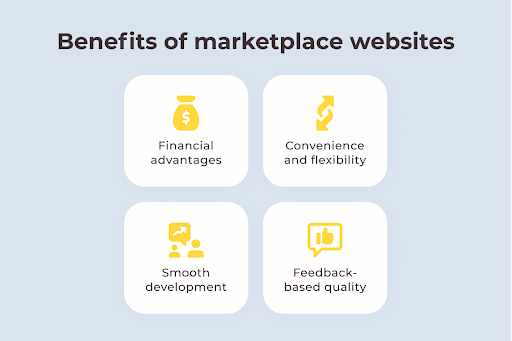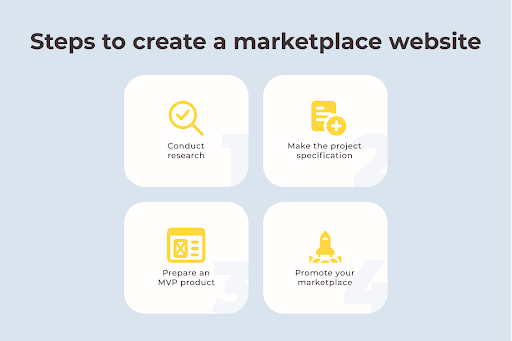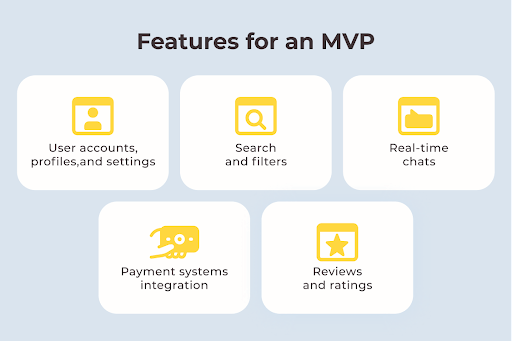In a current era, when offline stores close at every step, online sales are at their peak, and their popularity only grows. Thus, if you think about what software to invest in, building an online marketplace website is an excellent option to consider. The best thing about online platforms is that everyone can enter the niche and generate money.
Let’s consider how to build an online marketplace website along with must-have features and development costs.
Key Benefits of Building an Online Marketplace Website
Let’s see why starting a marketplace business is worth the effort.

Financial benefits
The Marketplace platform allows you to make money fast. You won’t need to deploy manufacturing or manage the supply chain. All you need – create a user-generated platform and start a promotion.
Convenience
There is a close relationship between high-quality products and users’ interests. If you have a good product, it’ll attract more potential buyers. In tune, the last ones will generate more sellers. Thus, your marketing campaign will be more effective since consumers and merchants engage each other.
Easy development
There are many hiring options available: freelance developer, in-house team, outsourcing software development company. However, if you want to take all the development hassles off your shoulders, it’s better to outsource the project.
Improved product quality
You’re not the one who is responsible for goods quality. You can make customers contribute to product quality by developing a rating system or enabling them to leave products’ reviews.
How to Create an Online Marketplace Website
When deciding to build a marketplace platform, you have two development options: design a custom website or apply a ready-to-use platform like WooCommerce, Magento or Sharetribe. Out-of-the-box solutions are the easiest and fastest way to create an online store. However, they are designed for the mass market, so you won’t be able to customize your product to business needs and goals.
In turn, developing a project from scratch allows you to present unique design and functionality, thus improving users’ experience and generating more money, respectively. Therefore, I decided to focus on custom marketplace website development, so here are the steps you should follow.

Step #1. Conduct research
Research is of great importance for any project. Firstly, you need to figure out what type of online marketplace you want to create and what value it will bring to customers. Or, in other words, what customers’ problems it will solve.
After, conduct a competitor analysis to see what proposal exists and how you can compete with the market leaders. If your desired niche is oversaturated, try to restrict your focus geographically or in the context of offered goods/services. Or concentrate on a less competitive niche.
Finally, define your target audience and identify segments to understand what features to add to meet clients’ expectations.
Step #2. Make a Project Specification
Specification document creation conducts on Discovery Phase. At this stage, you already have an IT vendor you cooperate with. In case you work with freelance developers, you’ll need to provide them with a detailed project statement by yourself (desired features, design, integration with 3rd parties services, etc.). On the other hand, suppose you’re outsourcing the product development to an experienced software development company. In that case, their Business Analysts will help you draw up a specification and consult on functionality that needs to be implemented first. This stage is vital to ensure the vendor’s vision is aligned with the project’s requirements.
Step #3. Start with MVP Development
Even though you’re assured of project success, there is no need to invest in creating a full-fledged website. Instead, it’s better to start with minimum valuable product development (MVP) to test waters, gather initial feedback, and make improvements based on users’ feedback. And all that without significant investments.
Marketplace website MVP is a platform with the basic features that help carry out the website’s primary function and attract first customers. Further, when you start generating money, you can proceed to develop advanced functionality.
Now, let’s discuss the marketplace website’s MVP features.

User accounts, profiles, and settings
The marketplace platform demands two types of users: Purchasers and Sellers. Both sides require features aimed to satisfy their specific needs.
Features for sellers
- Registration
- Well-designed navigation
- Search and filtering
- Access to Sellers’ profiles
Features for buyers
- Registration
- Profile management
- Ability to add new stock items/services
Search
Your online ordering engine has to work seamlessly. If customers experience some discomfort looking for goods or services (for example, complicated design or system slowness), they won’t use your platform. Besides, you should add filters and relevant suggestions to provide a convenient searching flow. Filtering allows users to organize results based on their needs. And suggestions accelerate the goods/service search and may stimulate buyers to purchase additional items.
Chats
Purchasers may have some questions regarding products or services, so real-time chat implementation is crucial. Moreover, customers wait for fast services, so consider adding an AI-based chatbot to provide users with instant answers.
Payments
When dealing with payments, it’s crucial to ensure safe money transfers. Therefore, you can implement trustful payment gateways like PayPal or Braintree or use 3-rd party services like Visa and Mastercard. The main advantage of the payment systems is that they are responsible for security transactions and are easy to integrate. Moreover, they submit SDKs that assist programmers in payment gateway integration.
Reviews and ratings
After the sale is made, clients should have an opportunity to post feedback and rate the merchant.
Step #4. Promote Your Platform
After you publish your marketplace website, you need to consider advertising campaigns to engage new clients and expand your existing customers’ base (users attracted on a previous stage). Be patient. Turning a startup into a lead generation machine is a day-to-day activity. Ideally, it’s better to start your promotion campaign long before you release a full-fledged platform. Preparation steps will help you captivate customers’ attention easier and increase brand loyalty.
Critical Things to Design an Online Marketplace
Along with development-related issues, you should consider domain name, web hosting account, SSL certificate, content management system, and payment solutions. So let’s consider them step-by-step.
Domain name
The domain name allows users to find and connect to your website by typing its address into the search line (e.g., walmart.com). How do you choose a proper domain name?
- It should comply with your brand name
- Keep it short
- Don’t apply numbers
- Use keywords to make your platform more SEO-friendly
You can’t take existing domain names, so you’ll need to cross a bunch of variants to pick the appropriate one. Domain name cost starts from $15.99 annually.
Web Hosting Account
Web hosting is the home of your marketplace website, where all information is stored. When users enter your website mane, it’s turned into the IP address of the computer of your web hosting provider. The centralized system keeps your platform’s files and sends them back to users’ browsers. The average web hosting price varies between $1.58 and $10.00 per month. The most demanded providers are:
- Namecheap
- Bluehost
- Hostgator
- Hostinger
SSL Certificate
SSL Certificate makes it possible to secure and protect private data. For example, every time information between a website and web server is exchanged, an SSL certificate is involved. Besides, if your platform is SSL permitted, search engines will rank it higher. You can consider the list of best SSL certificate providers to choose the right security at the lowest price.
Content Management System
A content management system or CMS is designed to let you edit, create, and handle a website’s content without coding background. Besides, it allows users to modify the online store. For instance, you can post an advertising banner or add a new website sanction.
Ready-made CMS software assists you in reducing time to market and cutting down the marketplace website development cost. However, they offer limited functions and are vulnerable to cyberattacks.
Payment Solutions
Let’s see the most popular ways of processing transactions:
- Direct payments. This method means that your website doesn’t take part in transaction processing. However, in this instance, you can’t charge commissions and handle returns. Moreover, such a payment type doesn’t enable purchasers to buy goods from different merchants simultaneously and make them pass over the checkout process for each deal separately.
- Aggregated payments. Such a payment type indicates that your marketplace website gets involved in the transactions. The platform holds the clients’ money and spreads them between sellers via payouts after the deal is made. Unlike direct payment, you get a chance to manage payments, and there is no need to go through multiple checkouts. However, you need to track dealers’ finance and control regular payouts.
- Parallel payments. Parallel payments are related to payment services such as PayPal or Stripe. In this case, your website acts as a mediator between sellers and buyers. The payment providers break up consumers’ payments at checkout and allocate them among sellers. Payment services are the ones who are responsible for secure transactions.
Cost to Develop a Marketplace Website
Since you already know all the stages and core features of marketplace website development, it’s time to delve into the price of making a marketplace platform. The average cost can vary between $30,000 and $200,000. The final price will depend on features and their complexity, design, the number of pages, third-parties integrations, and developers’ rate.
Development costs consist of development and non-development time needed to create and deploy the product’s functionality.
The number of hours depends on features’ complexity and includes both frontend and backend development. After defining how much it will take to fulfill the project, you can calculate the cost by multiplying hours by developers’ hourly rate.
The vendors’ rate can vary depending on what hiring option you choose: freelance vs. full-time programmers vs. outsourcing software development company. So, let’s consider the for and against of each cooperation model.
Independent contractors
There are a lot of hiring platforms like Upwork or Toptal where you can find freelance developers for a reasonable price. However, it’s a good option if you need to implement a small part of the software, as one freelancer can’t be responsible for an entire cycle of marketplace website development.
Benefits:
- Low-cost solution;
Drawbacks:
- If you don’t have a tech background, you’ll need to look for a specialist to check the product’s compliance;
- You’ll need to hire a project manager to take control over the process;
- You should provide detailed project specifications and draw up a work plan for the next weeks;
- Freelancer programmers don’t offer you a thorough estimate because of a lack of analytics skills;
- Last but not least, they can leave the project without notice for a better proposal.
Full-time developers
You can assemble an in-house team to have complete control over the marketplace website development process. However, it’s a costly option since it requires additional expenses.
Benefits:
- You’ll be entirely involved in the process;
- Communication is on a high level;
- Software developers are available round the clock.
Drawbacks:
- You will also need to hire additional specialists to help you with projects specification, team management, and testing part;
- Time-consuming hiring process since you’ll need to recruit each specialist individually;
- This model requires additional expenses on rent, software, hardware, salaries, taxes, etc.
Outsourcing Agencies
You can outsource marketplace website development or expand your team with software engineers from an outsourcing agency. In both cases, you’ll reduce the time to release and get a first-class product for an affordable price.
Benefits:
- You get access to a great pool of experienced specialists;
- They have Business Analysts on their side to provide you with detailed project estimates;
- Turnkey testing;
- Consult you on the project’s features and prepare project specifications;
- Guarantee project delivery within negotiated time.
Drawbacks:
- Outsourcing companies will cost you less than full-time developers but more than Independent contractors.
The final choice will depend on your preferences and business needs. It’s better to consider all advantages and disadvantages of every cooperation model to make a reasonable decision.
Wrapping Up
Marketplace website development is a multi-stage process requiring considerable preparations and expertise in the field. You have to scrutinize the market, define a unique value proposition, and add the features that align with users’ demands. And the final success will depend on the vendor’s experience. Therefore, it’s vital to find experts who’ll be able to transform your startup idea into a sophisticated and fully functional platform.


